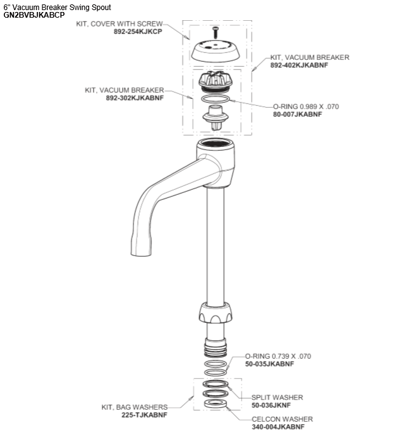Attention all school building engineers and lab building engineers — do your laboratories utilize vacuum breakers? Vacuum breaker lab faucets offer extra functionality and usage to your water systems. In this article, we’re diving into the top questions asked about vacuum breaker faucets, so you can better understand why they are a smart investment for your space.
What is your backflow risk? Are prevention devices available?
Backflow risk refers to the potential of dirty water entering your potable water supply. If this were to happen, your potable water would be at risk for contamination. Of course, the goal of proper plumbing is to maintain the sanitation of potable water — especially in high-tech areas like school laboratories. To minimize risks associated with backflow, it's imperative to consider the installation of backflow prevention devices. Custom laboratory faucets and fittings, including vacuum breakers are a great way to reduce your chance of contamination.
Why do labs need vacuum breakers on faucets?
Installing new laboratory faucets and fittings is important for any school, hospital, or research lab. Laboratories conduct research and demand precise results. Therefore, it's necessary to equip your lab space with top-of-the-line appliances.
Vacuum breakers enhance lab faucets in many ways. First, they reduce the possibility of contaminating public waters with harsh chemicals that could be used in your lab. In fact, most cities have regulations regarding the water that flows out of laboratories and into public systems. So, you can rest assured that your lab is doing its due diligence to avoid any contamination.
Additionally, choosing faucet fittings with satin antimicrobial (SAM) finishes will reduce and protect against the spread of bacteria in your own lab. By decreasing bacteria, you can trust that your lab faucet fittings are working to decrease bacteria present in the water you may use for lab projects.
How do you install a vacuum breaker?
When installing a vacuum breaker, the water supply must be completely clear. Flush your water supply line prior to installation to avoid any debris that could foul the vacuum breaker, prevent proper sealing, or damage components of your new lab faucet system.

Vacuum breakers are usually installed as a part of a lab faucet gooseneck. However, vacuum breakers can also be incorporated between remote control water valves and outlet fittings. All vacuum breakers must be installed at a level position and atmospheric vacuum breakers should be placed downstream from the final valve in the water supply line.
Keep in mind, good installation is key to the functionality of your vacuum breaker faucet, allowing it to last longer with fewer leaks and complications. And, each laboratory will have unique needs and requirements. To ensure that your system is performing at optimal levels, it’s recommended to have your faucet installed properly by a professional — or that you consult a local plumbing contractor during the installation process.
How do vacuum breakers work?
An atmospheric vacuum breaker aims to reduce contaminated water and provide a potable water supply to your faucets. It does this by preventing back-siphonage. Back-siphonage occurs when there is negative pressure in pipes, allowing for water to flow opposite of the normal direction.
By installing a vacuum breaker, you’ll have backflow prevention and reduce the chances of contaminated water running through your faucet.
When the vacuum breaker is operating as it should, you may find that water flows out of the faucet after it has been turned off. This small amount of drainage is expected and actually shows that the vacuum breaker is operating properly. When the faucet turns off, gravity allows the water remaining in the spout to flow downstream and out of the faucet. With that being said, vacuum breakers and laboratory faucets do require occasional maintenance.
What kind of maintenance does a vacuum breaker need?
For optimal performance, as with any system, vacuum breakers in lab faucets require routine maintenance. Systematic inspections, cleaning, and replacement of worn-out parts is required. During maintenance checks, look for mineral deposits, loosened seals, and other possible deterioration.
What vacuum breaker should you purchase?
With a vast array of products for you to choose from, Chicago Faucets can help optimize your laboratory usage, safety, and efficiency. In fact, at Chicago Faucets, we offer over 8,000 products to customize your unique lab space. Chicago faucets offers both Legacy Lab Fittings (which are unassembled) and New Lab Fittings (which are pre-assembled and tested).
Not to mention, our durable and reliable faucets are backed by the industry’s strongest warranties. For safer, healthier labs and schools consider installing vacuum breakers on your faucets.
Are you ready to get install new faucets? Or would you like to learn more about the options available for your facility? Contact us or visit our FAQs page.
.png)

